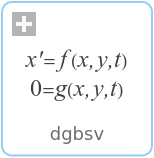WOLFRAM SYSTEM MODELER
dgbsvSolve real system of linear equations A*X=B with a B matrix |
|
Wolfram Language
In[1]:=

SystemModel["Modelica.Math.Matrices.LAPACK.dgbsv"]
Out[1]:=

Information
This information is part of the Modelica Standard Library maintained by the Modelica Association.
Lapack documentation
Purpose
=======
DGBSV computes the solution to a real system of linear equations
A * X = B, where A is a band matrix of order N with KL subdiagonals
and KU superdiagonals, and X and B are N-by-NRHS matrices.
The LU decomposition with partial pivoting and row interchanges is
used to factor A as A = L * U, where L is a product of permutation
and unit lower triangular matrices with KL subdiagonals, and U is
upper triangular with KL+KU superdiagonals. The factored form of A
is then used to solve the system of equations A * X = B.
Arguments
=========
N (input) INTEGER
The number of linear equations, i.e., the order of the
matrix A. N >= 0.
KL (input) INTEGER
The number of subdiagonals within the band of A. KL >= 0.
KU (input) INTEGER
The number of superdiagonals within the band of A. KU >= 0.
NRHS (input) INTEGER
The number of right hand sides, i.e., the number of columns
of the matrix B. NRHS >= 0.
AB (input/output) DOUBLE PRECISION array, dimension (LDAB,N)
On entry, the matrix A in band storage, in rows KL+1 to
2*KL+KU+1; rows 1 to KL of the array need not be set.
The j-th column of A is stored in the j-th column of the
array AB as follows:
AB(KL+KU+1+i-j,j) = A(i,j) for max(1,j-KU)<=i<=min(N,j+KL)
On exit, details of the factorization: U is stored as an
upper triangular band matrix with KL+KU superdiagonals in
rows 1 to KL+KU+1, and the multipliers used during the
factorization are stored in rows KL+KU+2 to 2*KL+KU+1.
See below for further details.
LDAB (input) INTEGER
The leading dimension of the array AB. LDAB >= 2*KL+KU+1.
IPIV (output) INTEGER array, dimension (N)
The pivot indices that define the permutation matrix P;
row i of the matrix was interchanged with row IPIV(i).
B (input/output) DOUBLE PRECISION array, dimension (LDB,NRHS)
On entry, the N-by-NRHS right hand side matrix B.
On exit, if INFO = 0, the N-by-NRHS solution matrix X.
LDB (input) INTEGER
The leading dimension of the array B. LDB >= max(1,N).
INFO (output) INTEGER
= 0: successful exit
< 0: if INFO = -i, the i-th argument had an illegal value
> 0: if INFO = i, U(i,i) is exactly zero. The factorization
has been completed, but the factor U is exactly
singular, and the solution has not been computed.
Further Details
===============
The band storage scheme is illustrated by the following example, when
M = N = 6, KL = 2, KU = 1:
On entry: On exit:
* * * + + + * * * u14 u25 u36
* * + + + + * * u13 u24 u35 u46
* a12 a23 a34 a45 a56 * u12 u23 u34 u45 u56
a11 a22 a33 a44 a55 a66 u11 u22 u33 u44 u55 u66
a21 a32 a43 a54 a65 * m21 m32 m43 m54 m65 *
a31 a42 a53 a64 * * m31 m42 m53 m64 * *
Array elements marked * are not used by the routine; elements marked
+ need not be set on entry, but are required by the routine to store
elements of U because of fill-in resulting from the row interchanges.
Syntax
(X, info) = dgbsv(n, kLower, kUpper, A, B)
Inputs (5)
| n |
Type: Integer Description: Number of equations |
|---|---|
| kLower |
Type: Integer Description: Number of lower bands |
| kUpper |
Type: Integer Description: Number of upper bands |
| A |
Type: Real[2 * kLower + kUpper + 1,n] |
| B |
Type: Real[n,:] |
Outputs (2)
| X |
Default Value: B Type: Real[n,size(B, 2)] |
|---|---|
| info |
Type: Integer |
